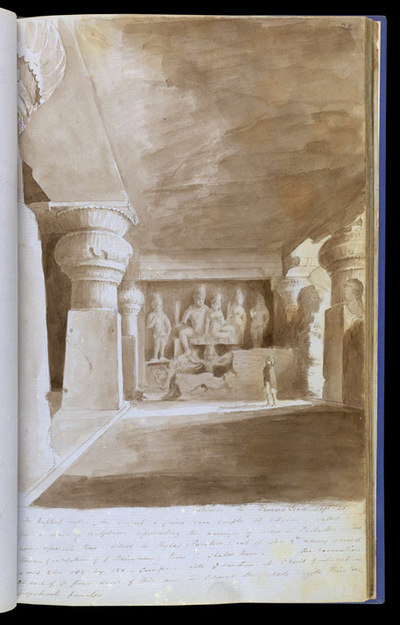Javascript must be enabled to continue!
f.25 Dumar Lena Cave with sculpture of Ravana rocking Mount Kailasa, Cave 29, Ellora. 'Entrance to Dhurma Lena. Septr. 25.'
View through Europeana Collections
Wash and watercolour drawing of the sculpture of
Ravana shaking Mount Kailasa from Dhumar Lena, Cave 29 at Ellora,
from an Album of 83 drawings; 80 of landscapes and antiquities in
the northem Deccan, 2 portraits and 1 flower study made during a
tour chiefly to Ellora, Rauza, Daulatabad, Aurangabad and Ajanta.
September to November 1849. Although the artist is unidentified,
these drawings are of some interest since they show the state of
the Ajanta and Ellora Caves soon after the Royal Asiatic Society
had brought them to the Company's notice in 1844. Robert Gill had
been deputed to make a record of Ajanta in 1846 and was presumably
on the spot when these sketches were made.The spectacular site of
Ellora, in Maharashtra, is famous for its series of Buddhist, Hindu
and Jain cave temples excavated into the rocky façade of a cliff
of basalt along more than 2 km. The works were done under the
patronage of the Kalachuri, the Chalukya and the Rashtrakuta
dynasties between the sixth and the ninth centuries. Dhumar Lena is
one of the earliest caves of the Hindu series and dates from the
Kalachuri period, early 6th century, as denoted by the similarity
between its columns and those at the Elephanta cave. Large-scale
sculpted wall panels on the sides represent Shaivite myths. The
sculpture depicted in this drawing represents Ravana shaking the
abode of Shiva and Parvati in the Himalayas.
Title: f.25 Dumar Lena Cave with sculpture of Ravana rocking Mount
Kailasa, Cave 29, Ellora. 'Entrance to Dhurma Lena. Septr.
25.'
Description:
Wash and watercolour drawing of the sculpture of
Ravana shaking Mount Kailasa from Dhumar Lena, Cave 29 at Ellora,
from an Album of 83 drawings; 80 of landscapes and antiquities in
the northem Deccan, 2 portraits and 1 flower study made during a
tour chiefly to Ellora, Rauza, Daulatabad, Aurangabad and Ajanta.
September to November 1849.
Although the artist is unidentified,
these drawings are of some interest since they show the state of
the Ajanta and Ellora Caves soon after the Royal Asiatic Society
had brought them to the Company's notice in 1844.
Robert Gill had
been deputed to make a record of Ajanta in 1846 and was presumably
on the spot when these sketches were made.
The spectacular site of
Ellora, in Maharashtra, is famous for its series of Buddhist, Hindu
and Jain cave temples excavated into the rocky façade of a cliff
of basalt along more than 2 km.
The works were done under the
patronage of the Kalachuri, the Chalukya and the Rashtrakuta
dynasties between the sixth and the ninth centuries.
Dhumar Lena is
one of the earliest caves of the Hindu series and dates from the
Kalachuri period, early 6th century, as denoted by the similarity
between its columns and those at the Elephanta cave.
Large-scale
sculpted wall panels on the sides represent Shaivite myths.
The
sculpture depicted in this drawing represents Ravana shaking the
abode of Shiva and Parvati in the Himalayas.
Related Results
f.28 Entrance to Dumar Lena Cave with sculpture of Siva's
Dance in the Elephant Skin, Cave 29, Ellora. 'Dhurma Lena. 26
Sept.'
f.28 Entrance to Dumar Lena Cave with sculpture of Siva's
Dance in the Elephant Skin, Cave 29, Ellora. 'Dhurma Lena. 26
Sept.'
Wash and watercolour drawing of the Dhumar Lena,
Cave 29 at Ellora, from an Album of 83 drawings; 80 of landscapes
and antiquities in the northem Deccan, 2 portraits and 1 flower
s...
Inscribed on reverse: 'Tin Tal Cave Ellora. March
1847'
Inscribed on reverse: 'Tin Tal Cave Ellora. March
1847'
Water-colour by Charles Power Cobbe of the Tin
Tal Cave at Ellora, dated March 1847. Inscribed on reverse: 'Tin
Tal Cave Ellora. March 1847 CPC'.Charles Power Cobbe was in the 8th
...
Entrance to the cave temple of Karle. Copy of an original
sketch of 1805
Entrance to the cave temple of Karle. Copy of an original
sketch of 1805
Water-colour by James Broff Byers of the entrance
to the cave temple of Karle, dated 1815. Inscribed on reverse:
'View of the Entrance, or External Appearance of the magnificent
Ca...
Archaeological Watching Monitoring, the Eastern part of the Sacristian vaults with cracks and secondary layers in the painting, Lena church, Lena parish 2018
Archaeological Watching Monitoring, the Eastern part of the Sacristian vaults with cracks and secondary layers in the painting, Lena church, Lena parish 2018
Archaeological Watching Monitoring, the Eastern part of the Sacristian vaults with cracks and secondary layers in the painting, Lena church, Lena parish 2018...
Cave 2, Entrance to Cell at Right Hand End of Porch
Cave 2, Entrance to Cell at Right Hand End of Porch
Pencil drawing of the entrance to the cell at the
right hand end of the porch of Cave 2 at Ajanta, from an Album of
26 ground plans of the Ajanta caves and 16 folios of drawings of...
Techo de los policromos de Altamira
Techo de los policromos de Altamira
More than 35.000 years ago, a member of a community living at the entrance of Altamira advanced deeper into the cave and, in a lower ceiling, drew a big abstract sign among other f...
View of the Entrance into the Cave near the Village of
Oreston
View of the Entrance into the Cave near the Village of
Oreston
View of the entrance of a cave in Oreston.
Oreston is near Plymstock, Hooe and Turnchapel. It is on the
opposite side of the Cattewater to Cattedown. In the early 19th
century ther...
X-radiograph(s) of "Madame Augustine Roulin Rocking a Cradle (La Berceuse)"
X-radiograph(s) of "Madame Augustine Roulin Rocking a Cradle (La Berceuse)"
X-Radiograph Description: X-Radiograph; Details : Head; Hands (little shows)
Burroughs Number: 2519
X-Radiograph(s) of:
Artist: Gogh, Vincent van, Dutch, 1853-1890
Title: ...




